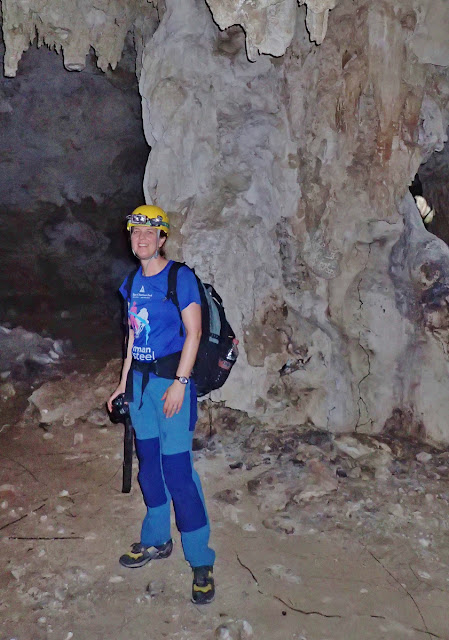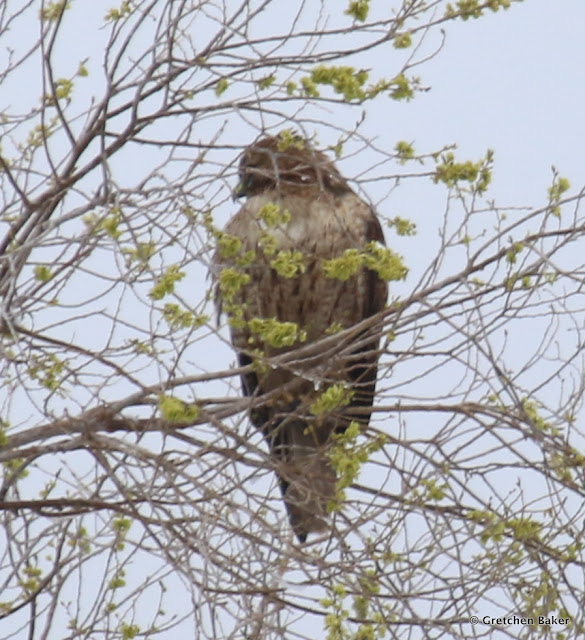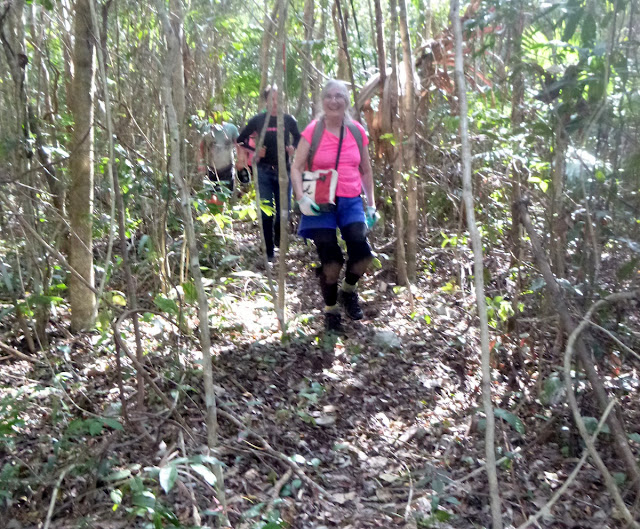Last night Desert Girl and I went up to the Astronomy program at Great Basin National Park. For the months of April and May, they are held at 7:30 p.m. on Saturday nights. They will be held three nights a week after Memorial Day weekend (I believe--check with the park at 775-234-7331 to be entirely sure) through Labor Day weekend.
One of the things we learned at the program was what a.m. and p.m. mean. I guess I hadn't really thought about it much. Ante meridian is Latin for before midday and post meridian is after midday. We also learned about Pope Gregory wiping out a week in October back about 852 and then the institution of the leap day so that wouldn't have to happen again. Except leap day isn't celebrated every 100 years, so it didn't happen in February 1900. But it did happen in February 2000 because every thousand years they need to put it back in. And sometimes there's a leap second, like in June 2015. Or something like that. But don't worry, the atomic clock is accurate to 1 second in 30 million years, based on the cesium atom. I think that's right. I wasn't exactly taking notes, but it was interesting.
Then it was time to line up at the telescopes and look at the night skies. There was a good turnout, as it was a clear night, and somewhat warm (above freezing, anyway). Probably about 40 people were there. It was cold enough that Desert Girl and I had on winter coats and winter boots and had two blankets and were still a bit chilled, but we were better prepared than most.
Desert Girl was a good sport while I took some photos of telescopes. One person had his own positioned near the Lehman Caves Visitor Center, which was lit up in red to preserve our night vision. The blue line is the glow-in-the dark paint along the curb.
We could find the Big Dipper easily, with the handle arcing to the bright star Arcturus, which Ranger Steve was pointing out. Through the telescope our first object was even easier to find--the moon. With a crescent, it made for some really great shadows.
Then we lined up again to take a look at Jupiter and four moons. I was also able to see these through our binoculars (binoculars, lawn chairs, and blankets are great things to bring to an astronomy program, as well as red flashlights).
Then it was on to the M3 globular cluster. It looked like a big fuzzy spot, even though it's made up of 500,000 stars. Why fuzzy? Well, it's over 30,000 light years away! There's nothing like looking up into the heavens to help put life into perspective.
Desert Girl had seen enough at this point, so we left, but other folks stayed on, looking at more amazing things. We hope to go to more astronomy programs this year, the kids really enjoy them, and it's always great to spend more time looking up at the stars and learning more about them.
Sunday, April 30, 2017
Wednesday, April 26, 2017
New Chicks
It's springtime, which means it's time for babies! In our case, we're looking at chicks. Last year we got six chicks, and we still have three beautiful hens that lay daily for us. We let them free range, which they absolutely love, but we figure it's only a matter of time before a dog or some other predator reduces our flock. So we bought six more chicks to increase our odds. Right now they're in a big tupperware container in the house, with food, water, and a heat lamp. They're assorted varieties, so that's fun.
The kids are delighted. Desert Girl in particular spends a lot of time with the chicks, holding them and talking to them and trying to come up with names for them.
The chicks have already grown a lot in one week, and we have to leave the container covered when we're not around, as they flap up to the sides of it. It won't be long till we move them outside and introduce them to the big hens.
The kids are delighted. Desert Girl in particular spends a lot of time with the chicks, holding them and talking to them and trying to come up with names for them.
The chicks have already grown a lot in one week, and we have to leave the container covered when we're not around, as they flap up to the sides of it. It won't be long till we move them outside and introduce them to the big hens.
Hopefully these chicks will be able to elude predators and live long lives!
Monday, April 17, 2017
Birds, Scenic Views, and More
March has been a month of variable weather, like usual. The snow is melting, the reservoirs filling, and the wind blowing. We can always count on the wind! We lost part of the roof on one of our outbuildings this month. Some other roofs blew off around town this spring, along with other structural damage. I guess it's been windier than usual. The clouds can be amazing, though.
I really like the dramatic clouds and snow-covered peaks!

We've gotten some snow, which always makes me admire the early flowers that can handle the snow and freezing. These are blossoms on one of our currant bushes.
The American Avocets are back. They are such pretty birds.

These chickens don't seem to mind the snow. Our last chickens wouldn't even leave the coop if there was snow, so it's neat to see these be a little more adventurous.
We often spot a red-tailed hawk in our trees or the neighbors'.
Desert Girl sometimes joins me on little rambles in the golden light, looking for good photos. She wants to win a big ribbon at the county fair this year.

One evening, Desert Girl joined me on a short-eared owl survey. We didn't see any short-eared owls, but we had some beautiful views. Here's Crystal Peak off in the distance.
And U.S. Highway 50, which seems to go on nearly forever.

We also saw this impressive load. We counted 50 tires. It must weigh a lot!

I really like the dramatic clouds and snow-covered peaks!

We've gotten some snow, which always makes me admire the early flowers that can handle the snow and freezing. These are blossoms on one of our currant bushes.
The robins are numerous now, and they get extra puffy when it's cold.
The American Avocets are back. They are such pretty birds.
The turkey vultures are migrating through. We'll see occasional ones throughout the summer, but spring and fall is when we see the most.
It's fun to watch them soar.

These chickens don't seem to mind the snow. Our last chickens wouldn't even leave the coop if there was snow, so it's neat to see these be a little more adventurous.
We often spot a red-tailed hawk in our trees or the neighbors'.
Desert Girl sometimes joins me on little rambles in the golden light, looking for good photos. She wants to win a big ribbon at the county fair this year.
We got a nice view of a Western Meadowlark that evening.

One evening, Desert Girl joined me on a short-eared owl survey. We didn't see any short-eared owls, but we had some beautiful views. Here's Crystal Peak off in the distance.
And U.S. Highway 50, which seems to go on nearly forever.

We also saw this impressive load. We counted 50 tires. It must weigh a lot!
It's fun seeing all the changes spring brings. Of course, if you don't like the wind or snow, it's possible to go hide in the kids' new fort--a buried 55-gallon drum.

Tuesday, April 11, 2017
Caving in Quintana Roo March 2017
Earlier in March I had the opportunity to go to Quintana Roo on a caving expedition. Quintana Roo is a Mexican state in the Yucatan peninsula. I found a cheap flight on Southwest to Cancun with Carol, a caver from California. We arrived to the warm, balmy weather, and our host and expedition organizer Peter picked us up and took us to his palapa in Paamul. Paamul is an RV park that has gotten fancy, with many RV owners putting thatched roofs over their RVs and sometimes enclosing the entire living space. Some are rather simple, others are deluxe, all are close to the beach.
The Paamul beach has a mixture of tidepools and white sand.
After a night to adjust, we headed into the jungle the next day to go survey caves.
For part of the two-hour hike, we hiked through caves, as it was easier than hiking through the jungle!

Here's a photo of me taken by Frank Bogle, one of the participants. The Melgarita cave pants did well on this trip (I took out the kneepads to make them cooler for the jungle hikes).

After surveying all day, it was time to eat and enter cave data. We returned several times to Mr. Trompo, an outdoor cafe on the pueblo side of Puerto Aventuras. Trompo is apparently a way to cook pork on a skewer. They put strong seasonings on it and it looks sort of like a carrot, including the color. You can imagine the fun we had with their logo. (Photo by Frank Bogle)

Each day was different. The second day of caving involved a lot of passage like this:
It felt like the room that never ended! Fortunately the water was warm. I was sketching each day, and seven days in a row really helped my sketching ability! The sketches, along with the measurements we take (distance, azimuth, inclination) help make the cave map.
A couple mornings I had energy to go for a run. North from Paamul was a lovely trail along the beach.

South of Paamul was a very rocky shoreline littered with ocean garbage, but the reward was a Mayan pyramid between two freshwater flows into the ocean. Here's the view from the top of the pyramid:
Each day we had different people helping with the cave survey, although for the week we had a core group of seven. We would get the lineplots, if they existed, the night before on our phone. Then we would tie into those the next day and continue surveying. Here's part of the group getting briefed on their mission.
For two days, Frank and I got to survey a wet cave, which involved inner tubes. They run snorkel tours through the cave. It was amazingly beautiful.
Another day we were again far out in the jungle, sketching in a line plot that some cave divers had surveyed. Then we found a little crawl that kept going and going, and eventually got to a huge magnificent room full of formations. And it kept going!
Sac Actun is a mostly underwater cave in the area that cave divers have been exploring for decades. It is the second longest cave in the world, after Mammoth Cave. We surveyed some cenote (sinkhole) entrances and added about 800 meters to the length one day. Here's a view of one of the sinkhole entrances. There's a diveline that goes back in the dark spot.
I'm not a cave diver, but I did go snorkeling! I went several times, amazed at the ocean life all around me. It was fun being in the waves.

I also snorkeled one of the cenotes, and saw these catfish. They were hanging out under some bats.
Pausing for a quick photo through some tree roots.
Here's an example of the data and sketch.
All too soon, the week came to an end. It was organized so well and I was able to totally put myself into the caving mentality so that's nearly all I thought about each day. It was a relaxing vacation because my mind wasn't whirring in a thousand directions like it usually does, instead I was very focused.
On my last day, I had a late afternoon flight, so in the morning I took the colectivo (bus) down to Tulum to see the ruins. Tulum is on the coast and very scenic.
I went early in the morning, as it's also very crowded.
High waves meant that you weren't allowed to go in the water past your knees, but that was okay, I was there for the view.
This iguana and I hung out in the shade for awhile.
Then it was time to fly home. There are lots of commercial caves and cenotes in Quintana Roo, so even if you're not on a survey trip, it's easy to experience the underground marvels of the Yucatan. I hope to go back, it's an amazing place! Thanks so much to Peter for organizing the trip and being such a great host, to Carol for being a wonderful traveling companion and roommate, Frank for letting me borrow some photos, my husband for agreeing that it was a good idea for me to go, and all those who took care of the kids while I went on a nourishing retreat!
 |
| Gretchen sketching in Cueva Olchun, Photo by Frank Bogle. |
Monday, April 3, 2017
Pronghorn Photo Shoot
I was driving back from photographing birds at the lake and literally had my camera with the telephoto lens on my lap when some pronghorn were right next to the road. What an opportunity! So I stopped, rolled down my window, and started snapping away.
The pronghorn are such interesting animals, North America's fastest land mammals. (There are invertebrates that are apparently even faster.) They used to have several relatives, but they died out at the end of the Pleistocene due to warmer climates (roughly about 10,000 years ago).
The pronghorn were definitely keeping an eye on me, and they moved a little further away.
But there were still close enough I could see them pooping.
They often have a characteristic when they poop called SPUD--scratch, paw, urinate, defecate. If you see little cleared areas near some pellets, they were probably made by pronghorn.
Another cool thing about pronghorn is that they don't jump over fences, instead they go underneath them. And if you ever have one running alongside your vehicle, slow down. They often will make a 90 degree turn and run right in front of you.
I felt so lucky to get to spend some time with them. And in fact, my photos of them were probably the best photos of the day!
Oh, what eyelashes! About the only thing cuter are baby pronghorn, which are generally born the end of May.

You can learn more about pronghorns here.
The pronghorn are such interesting animals, North America's fastest land mammals. (There are invertebrates that are apparently even faster.) They used to have several relatives, but they died out at the end of the Pleistocene due to warmer climates (roughly about 10,000 years ago).
The pronghorn were definitely keeping an eye on me, and they moved a little further away.
But there were still close enough I could see them pooping.
They often have a characteristic when they poop called SPUD--scratch, paw, urinate, defecate. If you see little cleared areas near some pellets, they were probably made by pronghorn.
Another cool thing about pronghorn is that they don't jump over fences, instead they go underneath them. And if you ever have one running alongside your vehicle, slow down. They often will make a 90 degree turn and run right in front of you.
I felt so lucky to get to spend some time with them. And in fact, my photos of them were probably the best photos of the day!
Oh, what eyelashes! About the only thing cuter are baby pronghorn, which are generally born the end of May.

You can learn more about pronghorns here.
Subscribe to:
Comments (Atom)
























































